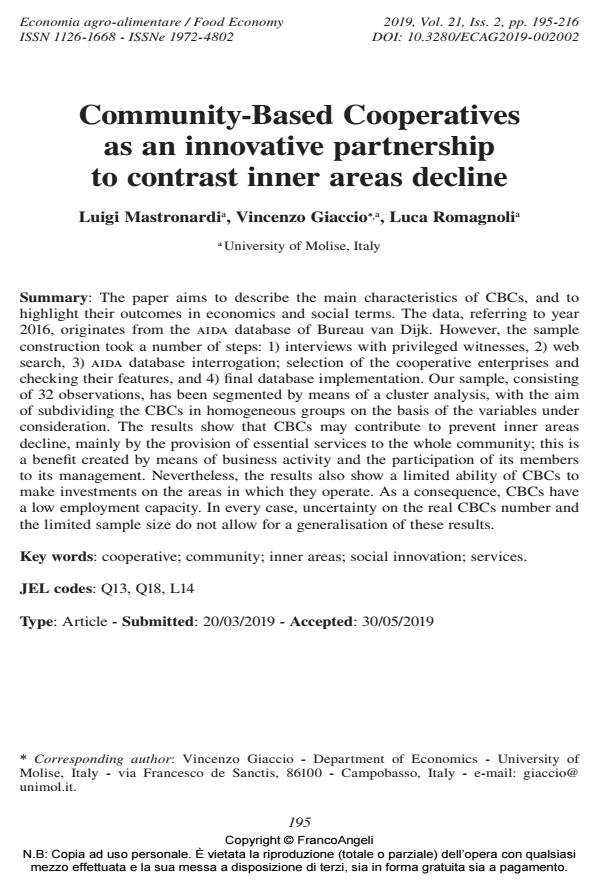Community-Based Cooperatives as an innovative partnership to contrast inner areas decline
Journal title ECONOMIA AGRO-ALIMENTARE
Author/s Luigi Mastronardi, Vincenzo Giaccio, Luca Romagnoli
Publishing Year 2019 Issue 2019/2
Language English Pages 22 P. 195-216 File size 158 KB
DOI 10.3280/ECAG2019-002002
DOI is like a bar code for intellectual property: to have more infomation
click here
Below, you can see the article first page
If you want to buy this article in PDF format, you can do it, following the instructions to buy download credits

FrancoAngeli is member of Publishers International Linking Association, Inc (PILA), a not-for-profit association which run the CrossRef service enabling links to and from online scholarly content.
The paper aims to describe the main characteristics of CBCs, and to highlight their outcomes in economics and social terms. The data, referring to year 2016, originates from the aida database of Bureau van Dijk. However, the sample construction took a number of steps: 1) interviews with privileged witnesses, 2) web search, 3) aida database interrogation; selection of the cooperative enterprises and checking their features, and 4) final database implementation. Our sample, consisting of 32 observations, has been segmented by means of a cluster analysis, with the aim of subdividing the CBCs in homogeneous groups on the basis of the variables under consideration. The results show that CBCs may contribute to prevent inner areas decline, mainly by the provision of essential services to the whole community; this is a benefit created by means of business activity and the participation of its members to its management. Nevertheless, the results also show a limited ability of CBCs to make investments on the areas in which they operate. As a consequence, CBCs have a low employment capacity. In every case, uncertainty on the real CBCs number and the limited sample size do not allow for a generalisation of these results.
Keywords: Cooperative; community; inner areas; social innovation; services.
Jel codes: Q13, Q18, L14
- Creative Cities of Gastronomy: Towards relationship between city and countryside Maria Bonaventura Forleo, Graziella Benedetto, in International Journal of Gastronomy and Food Science 100247/2020 pp.100247
DOI: 10.1016/j.ijgfs.2020.100247 - Bridging regional gaps: Community-based cooperatives as a tool for Italian inner areas resilience Luigi Mastronardi, Maria Giagnacovo, Luca Romagnoli, in Land Use Policy 104979/2020 pp.104979
DOI: 10.1016/j.landusepol.2020.104979 - Agri-Food Markets towards Sustainable Patterns Valeria Borsellino, Emanuele Schimmenti, Hamid El Bilali, in Sustainability /2020 pp.2193
DOI: 10.3390/su12062193
Luigi Mastronardi, Vincenzo Giaccio, Luca Romagnoli, Community-Based Cooperatives as an innovative partnership to contrast inner areas decline in "ECONOMIA AGRO-ALIMENTARE" 2/2019, pp 195-216, DOI: 10.3280/ECAG2019-002002